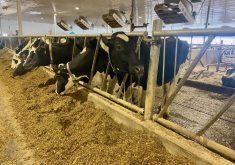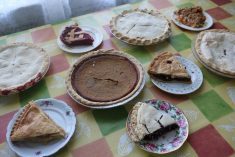I recently attended my 1961 University of Saskatchewan home economics class reunion in Edmonton. Two of our classmates live there and they invited us to their homes. We were a small class of 12 and with 10 able to attend, moving into their homes for a few days was possible and delightful. Since graduating, we have scattered from British Columbia to Ontario.
While in Edmonton, we visited many sights, caught up on what’s happening in our lives and enjoyed great food from a special cookbook.
Several months ago, we were asked to send our favourite recipes to our hosts Betty and Janice. They then organized, edited and arranged with a printer for a lovely 176 page coil bound cookbook to be ready for us when we arrived.
Read Also

Accurate accounting, inventory records are important
Maintaining detailed accounting and inventory records is not just a best practice; it’s a critical component of financial health, operational efficiency and compliance with programs like AgriStability.
It’s entitled Favourites from the Class of ’61. There is a picture of each of us and our biographies. It is a wonderful keepsake.
Here are some recipes from the book that we sampled and enjoyed during the reunion.
Bacon-wrapped water chestnuts
Betty’s recipe for this appetizer was a hit, served before dinner at
her house.
1 pound side bacon 500 g
2 cans (8 oz./250 g each)
whole water chestnuts,
drained
1/4 cup brown sugar 60 mL
1/4 cup Catalina salad 60 mL
dressing
1/4 cup homemade chili 60 mL
sauce
toothpicks
Cut bacon slices in half, place on paper towels and partially cook in microwave. Wrap each bacon strip around a whole chestnut and secure with a toothpick. Place wrapped chestnuts in a shallow 9 x 13 inch (22 x 33 cm) baking dish.
Mix together brown sugar,
Catalina dressing and chili sauce, then drizzle over bacon-wrapped water chestnuts. Bake in 350 F
(180 C) oven for 30 minutes.
Serve hot. Makes 40-44 appetizers.
Note: This recipe may be made ahead and reheated in the microwave.
Roasted vegetables
Janice’s recipe was served at her house.
2-3 green peppers 1-2 large white
or red onions
3 sweet potatoes
(yams)
1 small butternut
squash or potatoes 2 tablespoons 30 mL
oil
2 tablespoons brown 30 mL
sugar or maple syrup
2 teaspoons basil 10 mL
dill seed
salt and pepper
Remove seeds from the peppers and cut in two-inch (five cm) pieces. Cube other vegetables or cut squash in rings if small. Toss with oil, making sure they’re well coated. Add brown sugar or maple syrup and basil. Add dill and salt and pepper, to taste. Put vegetables in a large baking pan. Bake vegetables at 400 F (200 C) for 35-45 minutes, uncovered, stirring often.
Makes eight to 10 servings.
Dream cake
Leone’s recipe. Very good.
Base:
1 cup flour 250 mL
1 tablespoon white 15 mL
sugar
1/4 teaspoon salt 1 mL
1/2 cup butter 125 mL
Topping:
1 cup brown sugar 250 mL
1 teaspoon baking 5 mL
powder
2 tablespoons flour 30 mL
1 cup raisins 250 mL
1 teaspoon vanilla 5 mL
2 eggs, beaten
Base: Combine flour, sugar, salt and butter and mix well. Spread in 8 x 8 inch (20 x 20 cm) cake pan and bake at 350 F (180 C), until straw coloured.
Topping: Combine brown sugar, baking powder, flour, raisins, vanilla and beaten eggs. Mix well and spread on top of base. Return to oven and bake until golden brown.
I doubled it for a 9 x 13 inch (22 x 33 cm) cake pan.
Berry time
We are told that berries are good for us, and besides that, they taste so good. I’m having a race with the birds to try and get a few of the saskatoon berries off my two little trees in the back yard. Fortunately the birds don’t care for raspberries, and so every day I can get a handful or two from the bushes along the back fence.
Berries are generally rich in vitamin C and fibre, yet low in calories. They also provide fair amounts of folate and potassium. But what makes berries special are their
phytochemicals, especially the
anthocyanins, which are the pigments that give them their intense blue, purple and red colouring.
Anthocyanins are potent antioxidants that fight oxidative cell damage and may reduce the risk of cancer and heart disease.
Berries rank higher in anti-
oxidant power than most fruits
and vegetables.
In animal and lab studies, berries have been found to improve memory and other brain functions, and they may inhibit tumour growth, decrease blood clotting and have other beneficial effects.
Cranberries and possibly other berries can help reduce urinary tract infections by preventing bacteria from adhering to cells on the lining of the bladder. Though most health benefits are far from proven, berries are an all-around good food to include in your diet several times a week.
A three year study by Dr. David Kitts at the University of British
Columbia, in conjunction with Riverbend Plantation Inc. of Saskatoon and Saskatchewan’s Agriculture Development Fund that supported the study, showed that saskatoon berries contain antioxidants comparable in activity to blueberries, blackberries and grape seed extract. We can now add saskatoon berries to the list of berries that we already knew were high in antioxidants.
* Local or homegrown berries usually taste best. Berries should be dry, firm and plump.
* Size doesn’t matter, but colour does. For example, blueberries should be deep blue-purple and strawberries a bright red with green caps attached.
* Refrigerate berries, but to prevent spoilage don’t wash them until you eat them.
* Freeze extra berries. Arrange unwashed dry berries in a single layer on a cookie sheet. When frozen, seal berries in a plastic bag or container. Rinse gently before eating. Use within a year.
* Store-bought frozen berries are a convenient alternative. Berry juices are increasingly available. But watch out for syrups in canned berries, which add calories. Berry jams retain only minuscule amounts of vitamin C and are mostly sugar. Dried berries may also have fewer nutrients and added sugar.
* Be aware that cooking destroys much of the vitamin C and folate in berries, but not the fibre or most phytochemicals.
Source: University of California, Berkeley Wellness Letter, July 2006.
Chilled cucumber soup
I tried this chilled soup and liked the cucumber and dill flavours used together. It is a cool taste for a hot summer day.
2 tablespoons butter 30 mL
3 cups cucumber, 750 mL
peeled, seeded and
chopped
1 medium onion, finely
chopped
2 tablespoons flour 30 mL
1 teaspoon salt 5 mL
1/8 teaspoon pepper, 0.5 mL
white is best
1 tablespoon lemon 15 mL
juice
2 cups chicken broth 500 mL
1/4 teaspoon dry dill 1 mL
weed
1/4 cup sour cream, 60 mL
optional
fresh dill weed for garnish
*No need to seed an English
cucumber.
*Chicken Oxo mixed with water or a tin of chicken broth can be used for the chicken broth.
Melt butter in frying pan. Add cucumber and onion. Sauté until about half of the cucumber liquid has evaporated, about 10 minutes.
Mix flour, salt and pepper. Stir in lemon juice, chicken broth and dill weed. Heat and stir until it boils and thickens. Cool slightly. Whisk in the sour cream. Run through blender.
If you prefer chunky soup, omit the blender step. The soup may be frozen at this point.
Chill. Garnish and serve.
It can also be made as a hot soup. To serve hot, substitute milk for the chicken broth. Heat to simmering temperature, garnish and serve.
Makes about three cups (750 mL).
Adapted from Company’s Coming Soups and Sandwiches by Jean Paré.
Alma Copeland is a home economist from Elrose, Sask., and one of four columnists comprising Team Resources. Send
correspondence in care of this newspaper, Box 2500, Saskatoon, Sask., S7K 2C4 or contact them at team@producer.com.














